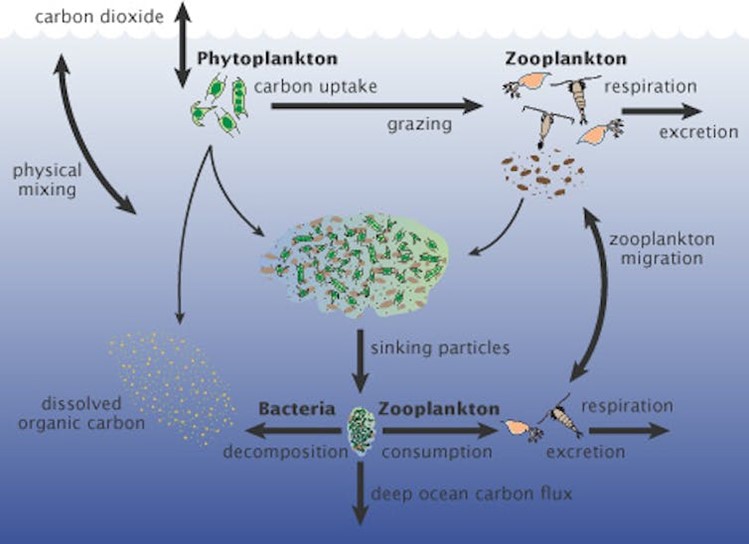
Credit: Contains modified Copernicus Sentinel data 2021, attribution, via Wikimedia Commons
Oxygen. Without it, life on Earth would look very different. Because only plants and a few types of microorganisms can live without it.
Fortunately, plants originated 3.5 billion years ago. They inhaled so much carbon dioxide and exhaled so much oxygen that they changed Earth’s atmosphere. With more oxygen in the air, Earth could sustain animal life -- which would eventually become us.
Those first plants looked a lot different than you might imagine. They were phytoplankton, single-cell algae adrift in the surface layers of oceans. The largest were just one millimeter in diameter, and many far smaller.
Those same kinds of phytoplankton still exist today, in massive quantities, in every ocean. They were the base of the marine food web then and still are today. Without them, ocean ecosystems would collapse.
And, they still provide a great deal of Earth’s oxygen.
Just one type of phytoplankton—called cyanobacteria, or blue-green algae—makes a whopping 20% of our oxygen. That’s more than all of Earth’s rainforests put together!
Another 30% comes from other kinds of phytoplankton and marine plants, meaning fully half of Earth’s oxygen comes from the ocean. Every other breath you take!
We talk a lot about ocean health on EarthDate, and this is another reason why. The ocean and its trillions of microscopic algae literally make the air we breathe.
Background
Synopsis: The oceans are full of tiny organisms that we call plankton. One type, phytoplankton, are capable of photosynthesis and form the base of marine food webs – without them Earth's ocean ecosystems would collapse. On top of that, as they consume carbon dioxide and water to make energy through photosynthesis, they give off oxygen as a waste product. Today, just one species of phytoplankton produces 20% of Earth’s oxygen. Plankton also sequester about 40% of Earth’s natural carbon dioxide production.
- Plankton are organisms that are too small to swim against currents, so they float passively or propel themselves in limited ways as ocean currents sweep them from place to place. They can be found in every drop of seawater and are crucial to life in Earth’s oceans.
- The word plankton comes from the Greek planktos which means wandering or drifting.
- The individuals that make up plankton are called plankters, and these range in size from tiny microbes to much larger jellyfish.
- Organisms that can swim against currents are called nektonic animals. Some of these spend the planktic larval part of their lives drifting with the currents.
- There are two main types of plankton.
- Phytoplankton are tiny plantlike organisms that use sunlight, carbon dioxide, water, and chlorophyll to make their own food (energy) through photosynthesis, burping up oxygen as a waste product. They range in size from 0.002 mm to 1 mm and blanket the surface layers of the world oceans in “blooms,” forming the essential foundation of global marine food pyramids. They include diatoms, dinoflagellates, radiolarians, ciliates, and cyanobacteria (blue-green algae).

A drop of seawater teems with life including phytoplankton (coiled filaments of cyanobacteria; rectangular algae called diatoms), zooplankton (bug-like copepods; long, glassy arrowworms; a big-eyed larval crab the size of a rice grain) and fish eggs.
Credit: Maia Valenzuela, CC BY 2.0, via Wikimedia Commons - Zooplankton are animals that eat phytoplankton, then are consumed by small crustaceans (like krill) and fish, which are devoured by larger species of sea animals (from barnacles to fish and whales).
- There are other free-floating functional groups of plankton. Bacterioplankton include bacteria and archaea that are sometimes grouped with phytoplankton, mycoplankton are fungus-like organisms, and virioplankton are tiny viruses.
- Phytoplankton are tiny plantlike organisms that use sunlight, carbon dioxide, water, and chlorophyll to make their own food (energy) through photosynthesis, burping up oxygen as a waste product. They range in size from 0.002 mm to 1 mm and blanket the surface layers of the world oceans in “blooms,” forming the essential foundation of global marine food pyramids. They include diatoms, dinoflagellates, radiolarians, ciliates, and cyanobacteria (blue-green algae).
- One genus of phytoplankton that carries a remarkable load is a tiny variety of cyanobacteria known as Prochlorococcus.

Transmission electron microscopy (TEM) image of Prochlorococcus marinus, a 0.6 micron (μm) phytoplankton cyanobacteria, with an overlay of green coloring.
Credit: Luke Thompson from Chisholm Lab and Nikki Watson from Whitehead, MIT, CC0, via Wikimedia Commons- At about 0.6 microns (μm), it is the smallest organism on Earth that is capable of photosynthesis. About 20,000 of these can fit in a single droplet of seawater.
- Plankton blooms can be extensive, some covering areas as large as Mexico, more than 750,000 mi2 (1,943,000 km2), larger than Alaska.
- Cyanobacteria have an extensive fossil record, dating back to 3.5 billion year old rocks of western Australia. Earth’s oxygen atmosphere was generated by cyanobacteria billions of years ago during the Archean and Proterozoic Eras, rendering it livable.
- Researchers estimate that Prochlorococcus in the world oceans produce 20% of the oxygen in the biosphere, meaning these huge phytoplankton blooms are responsible for one in every five breaths you take.
- That’s more oxygen than is produced by all the tropical rainforests on land.
- About half of Earth’s daily oxygen production is believed to come from the oceans, including Prochlorococcus, other phytoplankton and other sea life.
- Phytoplankton also sequester carbon dioxide, fixing 30-50 billion metric tons of carbon annually, which is about 40% of the total.

Phytoplankton in the ocean consume carbon dioxide as they photosynthesize. When they are eaten or decompose, some of the carbon they contain falls into the ocean depths.
Credit: Adapted from A New Wave of Ocean Science, U.S. Joint Global Ocean Flex Study, via NASA Earth Observatory
- Protecting Earth’s oceans safeguards the biological pump that helps us to breathe easier.

